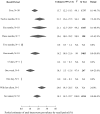What Proportion of Female Sex Workers Practise anal Intercourse and How Frequently? A Systematic Review and Meta-analysis
- PMID: 30953304
- PMCID: PMC6778486
- DOI: 10.1007/s10461-019-02477-w
What Proportion of Female Sex Workers Practise anal Intercourse and How Frequently? A Systematic Review and Meta-analysis
Abstract
HIV is more efficiently acquired during receptive anal intercourse (AI) compared to vaginal intercourse (VI) and may contribute substantially to female sex workers' (FSW) high HIV burden. We aim to determine how common and frequent AI is among FSW globally. We searched PubMed, Embase and PsycINFO for studies reporting the proportion of FSW practising AI (prevalence) and/or the number of AI acts (frequency) worldwide from 01/1980 to 10/2018. We assessed the influence of participant and study characteristics on AI prevalence (e.g. continent, study year and interview method) through sub-group analysis. Of 15,830 identified studies, 131 were included. Nearly all (N = 128) reported AI prevalence and few frequency (N = 13), over various recall periods. Most studies used face-to-face interviews (N = 111). Pooled prevalences varied little by recall period (lifetime: 15.7% 95%CI 12.2-19.3%, N = 30, I2 = 99%; past month: 16.2% 95%CI 10.8-21.6%, N = 18, I2 = 99%). The pooled proportion of FSW reporting < 100% condom use tended to be non-significantly higher during AI compared to during VI (e.g. any unprotected VI: 19.1% 95%CI 1.7-36.4, N = 5 and any unprotected AI: 46.4% 95%CI 9.1-83.6, N = 5 in the past week). Across all study participants, between 2.4 and 15.9% (N = 6) of all intercourse acts (AI and VI) were anal. Neither AI prevalence nor frequency varied substantially by any participant or study characteristics. Although varied, AI among FSW is generally common, inconsistently protected with condoms and practiced sufficiently frequently to contribute substantially to HIV acquisition in this risk group. Interventions to address barriers to condom use are needed.
Keywords: Anal intercourse; Female sex workers; HIV; Sexual behaviour.
Conflict of interest statement
We declare that there are no conflict of interest.
Figures



References
-
- Boily MC. The relative contribution of anal intercourse and primary infection to mature heterosexual HIV epidemics. Sex Transm Infect. 2011;87(Suppl 1):A38.

